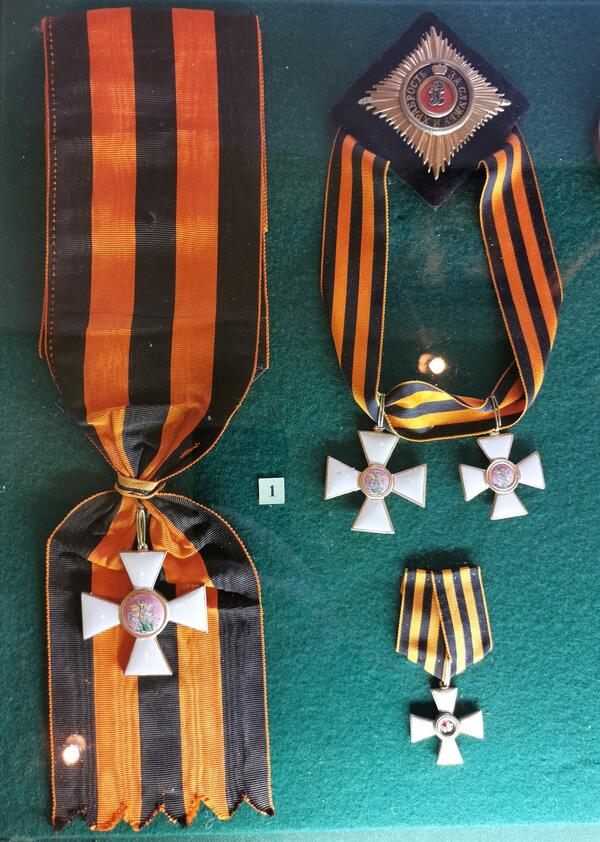In 1769, Catherine II established the Order of St. George as the highest military award. Any officer with the rank of ensign and higher, who proved his outstanding loyalty and bravery in battles, could be presented to the Order. However, the order’s statute stipulated that the lowest class could be bestowed also basing on the length of service: 25 years of service for field officers or 18 completed campaigns for naval officers.
The class of the award from the highest (the first class) to the lowest (the fourth class) was determined in each case separately and did not depend on other insignia. Only the monarch could personally and by his own decision grant two higher Orders of St. George, The 3rd and 4th classes were awarded at the request of the College of War upon presentation of a detailed story and evidence of the feat.
In 1769, for the “defeat of a multitudinous army” near Galați, Lieutenant Colonel Fyodor Ivanovich Fabrizien (Fabrizian) was awarded the 3rd class, becoming the first soldier to receive the newly established order for a battle.
There were a number of honorary privileges for St. George’s recipients. Depending on the class of the award, the recipient was entitled to an annual pension of 700, 400, 200 or 100 rubles. The Order protected from corporal punishment, and for those who did not have a noble title, it provided an opportunity to acquire it.
Since 1807, enlisted men who distinguished themselves in battles were conferred the Insignia of the Military Order, also known as a “soldier’s St. George Cross”. The number of awards was determined only by accomplished feats, so both St. George Crosses could be present on one uniform: an officer’s and a soldier’s, which was previously earned.
In the 19th century, clear criteria for granting it were established. The Order of the first class was awarded for a victorious campaign, and the second class — for an important battle.
Under Nicholas I, the so-called “Muslim” designs of the Order were created. As a sign of respect for a different faith, instead of St. George, they featured a double-headed eagle. However, as follows from memoirs of that time, Caucasian officers were often perplexed about the cross “with a bird, instead of a jigit.”
Up to and including 1917, the highest award was conferred on 25 people, 125 were presented to the second class, and about 650 to the third. The fourth class was granted to more than 15,000 officers and several army priests.
Mikhail Illarionovich Kutuzov, Mikhail Bogdanovich Barclay de Tolly, Ivan Ivanovich Diebitsch and Ivan Fyodorovich Paskevich became full Cavaliers of the Order of St. George.
Catherine II presented the “St. George Cross”, first class to herself when she established the order, and Alexander II did the same in honor of its centenary.
The class of the award from the highest (the first class) to the lowest (the fourth class) was determined in each case separately and did not depend on other insignia. Only the monarch could personally and by his own decision grant two higher Orders of St. George, The 3rd and 4th classes were awarded at the request of the College of War upon presentation of a detailed story and evidence of the feat.
In 1769, for the “defeat of a multitudinous army” near Galați, Lieutenant Colonel Fyodor Ivanovich Fabrizien (Fabrizian) was awarded the 3rd class, becoming the first soldier to receive the newly established order for a battle.
There were a number of honorary privileges for St. George’s recipients. Depending on the class of the award, the recipient was entitled to an annual pension of 700, 400, 200 or 100 rubles. The Order protected from corporal punishment, and for those who did not have a noble title, it provided an opportunity to acquire it.
Since 1807, enlisted men who distinguished themselves in battles were conferred the Insignia of the Military Order, also known as a “soldier’s St. George Cross”. The number of awards was determined only by accomplished feats, so both St. George Crosses could be present on one uniform: an officer’s and a soldier’s, which was previously earned.
In the 19th century, clear criteria for granting it were established. The Order of the first class was awarded for a victorious campaign, and the second class — for an important battle.
Under Nicholas I, the so-called “Muslim” designs of the Order were created. As a sign of respect for a different faith, instead of St. George, they featured a double-headed eagle. However, as follows from memoirs of that time, Caucasian officers were often perplexed about the cross “with a bird, instead of a jigit.”
Up to and including 1917, the highest award was conferred on 25 people, 125 were presented to the second class, and about 650 to the third. The fourth class was granted to more than 15,000 officers and several army priests.
Mikhail Illarionovich Kutuzov, Mikhail Bogdanovich Barclay de Tolly, Ivan Ivanovich Diebitsch and Ivan Fyodorovich Paskevich became full Cavaliers of the Order of St. George.
Catherine II presented the “St. George Cross”, first class to herself when she established the order, and Alexander II did the same in honor of its centenary.






